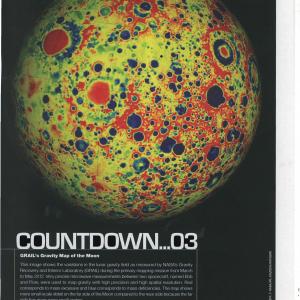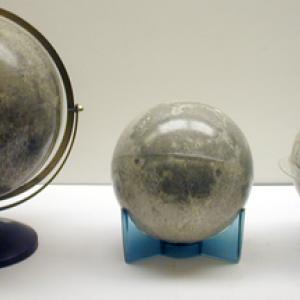College of Liberal Arts & Sciences
8A50.35 - The Moon
The moon globes can be a useful tool when talking about lunar phenomenon.
The Sky and Telescope Moon Globe is a mosaic of 15,000 images acquired by the LRO (Lunar Reconnaissance Orbiter) wide angle camera between Nov. 2009 and Feb. 2011. We also have the Sky and Telescope Topographic Moon Globe.
- James Lincoln, "Augmented Reality Moon for Astronomy Lessons", TPT, Vol. 56, #7, Oct. 2018, p. 492.
- Paul Hewitt, "Figuring Physics", TPT, Vol. 41, #6, Sept. 2003, p. 363.
- Janelle M. Bailey, "On the Nature of Moonquakes", TPT, Vol. 38, # 9, Dec. 2000, p. 522.
- Michael C. Lo Presto, "How Big Is the Moon?",TPT, Vol. 38, #3, Mar. 2000, p. 179.
- Mikolaj Sawichi, "Is The Moon Falling Upside Down?", TPT, Vol. 35, #6, Sept. 1997, p. 379.
- Timothy F. Slater, "Teaching the Science of Moon Gazing", TPT, Vol. 33, #3, Mar. 1995, p. 186.
- Peter Whiteley, "What 'Holds Up' The Moon",TPT, Vol. 32, #6, Sept. 1994, p. 348.
- William P. Lovergrove, "Moon Watching: An Experiment in Scientific Observation", TPT, Vol. 32, #2, Feb. 1994, p. 126.
- Jennifer Hickman and Maurice Bruce Stewart, "The Regression of the Moon's Nodes: A Major Project in Introductory Astronomy", TPT, Vol. 29, #3, Mar. 1991, p. 160.
- E. Jay Sarton, "Measuring the Moon's Orbit", TPT, Vol. 18, #7, Oct. 1980, p. 504.
- Van E. Neie, "How High Can You Jump on the Moon?", TPT, Vol. 11, #1, Jan. 1973, p. 43.
- David H. DeVorkin, "Determining The Distance To The Moon", TPT, Vol. 10, #1, Jan. 1972, p. 40.
- Allan Walstad, "Comment on the Center - of - Mass Offset of the Moon", AJP, Vol. 46, #7, July 1978, p. 762.
- Robert D. Vermillion, "On the Center-Of-Mass Offset of the Moon", AJP, Vol. 44, #10, Oct. 1976, p. 1014.
- William Hooper, "Lunar Gravity Measurement From Apollo 14 Television", AJP, Vol. 39, #8, Aug. 1971, p. 974.
- Laura Fattaruso, "Two New Minerals Found on the Moon", Physics Today, Vol. 77, #6, June 2024, p. 18.
- Jennifer Sieben, "Gravitational Patterns Reveal a Tumultuous Lunar Past", Physics Today, Vol. 77, #6, June 2024, p. 15.
- Brett Denevi, "The New Moon", Physics Today, Vol. 70, #1, June 2017, p. 38.
- Mark Wilson, "Thermodynamic Simulations Explain the Moon's Composition", Physics Today, Vol. 69, #1, Jan. 2016, p. 17.
- David Stevenson, "Alternative Hypotheses for Making the Moon", Physics Today, Vol. 68, #4, Apr. 2015, p. 8.
- Peter F. Coleman, "Alternative Hypotheses for Making the Moon", Physics Today, Vol. 68, #4, Apr. 2015, p. 8.
- Robert Vanderbei, "Alternative Hypotheses for Making the Moon", Physics Today, Vol. 68, #4, Apr. 2015, p. 8.
- Fred Brotz, "Dusting Off A Comet", Physics Today, Vol. 68, #1, Jan. 2015, p. 10.
- David Stenevson, "Making the Moon", Physics Today, Vol. 67, #11, Nov. 2014, p. 32.
- Mark Wilson, "Explaining Our Two - Faced Moon", Physics Today, Vol. 67, #1, Jan. 2014, p. 14.
- Donald U. Wise, "Alternative Models of the Moon's Origin", Physics Today, Vol. 67, #1, Jan. 2014, p. 8.
- Charles Day, "What Kept the Moon's Dynamo Alive??", Physics Today, Vol. 66, #6, June 2013, p. 17.
- Lindy Elkins-Tanton, "Water on the Moon", Physics Today, Vol. 64, #3, Mar. 2011, p. 74.
- Siegfried Bodenmann, " The 18th-Century Battle Over Lunar Motion", Physics Today, Vol. 63, #1, Jan. 2010, p. 27.
- Mark Wilson, "Isotope-Ratio Measurements Reveal a Young Moon", Physics Today, Vol. 61, #2, Feb. 2008, p. 16.
- Palmer Dyal and Curtis W. Parkin, "The Magnetism of The Moon", Scientific American, Vol. 224, #7 to 12, 1971, p. 63.
- Brian Mason, "The Lunar Rocks", Scientific American, Vol. 224, #7 to 12, 1971, p. 49.
- Daniel Herwartz, Andreas Pack, Bjarne Friedrichs, and Addi Bischoff, "Identification of the Giant Impactor Theia in Lunar Rocks", Science, Issue 6188, Vol. 344, June 2014, p. 1146.
- "July 24, 1954: Operation Moon Bounce", APS News, July 2012, p. 2.
- Jennifer Lehman, "Every Single Moon Ranked", Popular Mechanics, May/June 2024, p. 24.
- "Glossary Exosphere", Popular Mechanics, April 2014, p. 18.
- Lester Black, "Lunar Lost and Found", Popular Mechanics, Nov. 2011, p. 16.
- Rena Marie Pacella, "New Moonscape", Popular Mechanics, Apr. 2011, p. 14.
- "Lunar Pull", Popular Science, Mar. 2013, p. 24.
- "Supermoon", Ad Astra, Summer 2015, p. 11.
- "The Moon and Sun", Ad Astra, Winter 2013, p. 55.
- "GRAIL's Gravity Map of the Moon", Ad Astra, Spring 2013, p. 3.
- Marianne J. Dyson, "The New Face of the Moon", Ad Astra, Fall 2010, p. 38 - 41.
- Jearl Walker, "1.186, Seeing Only One Side of the Moon", The Flying Circus of Physics Ed. 2, p. 80.
- "Moon", Spring 2004, Science Supplement, or The 2004 World Book Science Year, Grolier Inc., ISBN: 0-7172-1580-6.
- Earths Moon = Isaac Asimov, "The Very Error of the Moon", Fantasy and Science Fiction Magazine.
- Earths Moon = Isaac Asimov, "The Moon and We", Fantasy and Science Fiction Magazine.
- "Category 2: The Solar System: The Moon", AB Secrets of the Universe, International Masters Publishers AB.
- Bathroom Readers' Institute, "The Moon", Uncle John's Bathroom Reader for Kids - Did You Know?, p. 230.
- "Moon Scam?", Uncle John's 'Unstoppable' Bathroom Reader, p. 278.
- "Mr. Moonlight", Uncle John's Bathroom Reader, p. 124.
Disclaimer: These demonstrations are provided only for illustrative use by persons affiliated with The University of Iowa and only under the direction of a trained instructor or physicist. The University of Iowa is not responsible for demonstrations performed by those using their own equipment or who choose to use this reference material for their own purpose. The demonstrations included here are within the public domain and can be found in materials contained in libraries, bookstores, and through electronic sources. Performing all or any portion of any of these demonstrations, with or without revisions not depicted here entails inherent risks. These risks include, without limitation, bodily injury (and possibly death), including risks to health that may be temporary or permanent and that may exacerbate a pre-existing medical condition; and property loss or damage. Anyone performing any part of these demonstrations, even with revisions, knowingly and voluntarily assumes all risks associated with them.

